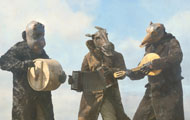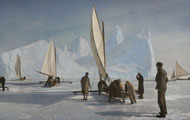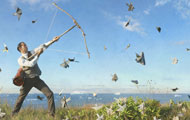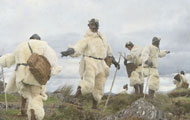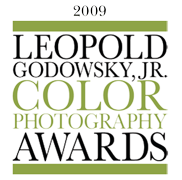


|

|

|
 |
 |
Click thumbnails to see full-sized images.

|

|
Nicholas Kahn and Richard Selesnick received BFAs from Washington University in St. Louis, MO in 1986. Since beginning their collaborative efforts, the artists have received a number of residencies and awards, including an Artist in Residence Grant at NASA, and a Fine Arts Work Center Fellowship. Their work has been shown in galleries and museums worldwide, most recently in solo exhibitions at Worlds End Contemporary, London, and John Michael Kohler Arts Center, Sheboygan, WI. Their photographs are included in numerous public and private collections, such as the Harvard Art Museum/Fogg Art Museum; Museum of Fine Arts, Houston; and the Philadelphia Museum of Art. The duo has three Aperture monographs to date: Scotlandfuturebog (2002), City of Salt (2005), and The Apollo Prophecies (2006). A book on Eisbergfreistadt is due out in 2010.
- Jennifer Uhrhane

In 1923, a huge iceberg drifted into the Baltic Sea and ran aground off the German port of Lübeck. The strength of the polar easterlies that year caused a number of bergs to drift unusually far south on the Spitsbergen current. Sea ice was seen in Bergen and parts of northern Scotland. Some German scientists postulated that the heat from factory smoke may have caused an abnormally high break up of the arctic ice pack. The burghers of Lübeck declared the iceberg to be a free trade area under the name "Eisbergfreistadt" (Iceberg Free State). It was hoped that the iceberg might become an offshore banking haven. Notgeld were issued as Marks but tied to financial futures and currency arbitrage. Some municipalities such as Bremen and Lübeck attempted to tie their own Notgeld to Eisbergfreistadt's by overprinting and stamping their own banknotes, but this "Eisberggeld" fared no better than the Mark during the height of hyperinflation.
Despite the failure of Eisbergfreistadt to take hold as a viable financial institution, it did nonetheless capture the public imagination of the time. To celebrate the founding of the Eisbergfreistadt bank, a large masquerade ball was held on the iceberg in the autumn of 1923. Many attendees came dressed as polar animals and explorers, although one contingent arrived dressed as pigs and rats. Unfortunately, the combined weight of the revelers caused the berg to split into two pieces. One of these eventually collapsed and melted, causing considerable damage to Lübeck's industrial zone; the other drifted back out into the Baltic, where it was swept back to the arctic by the Norwegian current.
In retrospect, the iceberg seems merely the precursor to the greater apocalypse to befall the town of Lübeck: in 1942 it became the first German city to be attacked by the Royal Air Force — the resulting firestorm almost completely obliterated the old town. After the war's end, the historic district was rebuilt and declared an UNESCO World Heritage Site in 1987. As such, the history of Lübeck seems particularly relevant to our contemporary anxieties, and we ignore its lessons at our peril.
— Nicholas Kahn & Richard Selesnick
John Michael Kohler Arts Center
www.kahnselesnick.com
www.carrollandsons.net












